Examining Classic Bioimpedance Vector Patterns Between BMI Classifications Among Community-Dwelling Older Women
Abstract
1. Introduction
2. Materials and Methods
2.1. Ethical Approval
2.2. Participants
2.3. Bioelectrical Impedance Analysis (BIA)
2.4. Statistical Analysis
3. Results
4. Discussion
5. Conclusions
Author Contributions
Funding
Institutional Review Board Statement
Informed Consent Statement
Data Availability Statement
Conflicts of Interest
Abbreviations
| BMI | Body Mass Index |
| BIA | Bioelectrical Impedance Analysis |
| BIVA | Bioelectrical Impedance Vector Analysis |
| Z | Impedance |
| Xc | Reactance |
| R | Resistance |
| H | Height |
References
- Peralta, M.; Ramos, M.; Lipert, A.; Martins, J.; Marques, A. Prevalence and trends of overweight and obesity in older adults from 10 European countries from 2005 to 2013. Scand. J. Public Health 2018, 46, 522–529. [Google Scholar] [CrossRef] [PubMed]
- Gao, Q.; Mei, F.; Shang, Y.; Hu, K.; Chen, F.; Zhao, L.; Ma, B. Global prevalence of sarcopenic obesity in older adults: A systematic review and meta-analysis. Clin. Nutr. 2021, 40, 4633–4641. [Google Scholar] [CrossRef] [PubMed]
- Fletcher, I. Defining an epidemic: The body mass index in British and US obesity research 1960-2000. Sociol. Health Illn. 2014, 36, 338–353. [Google Scholar] [CrossRef] [PubMed]
- Keys, A.; Fidanza, F.; Karvonen, M.J.; Kimura, N.; Taylor, H.L. Indices of relative weight and obesity. J. Chronic Dis. 1972, 25, 329–343. [Google Scholar] [CrossRef] [PubMed]
- Groothof, D.; Post, A.; Polinder-Bos, H.A.; Hazenberg, B.P.C.; Gans, R.O.B.; Bakker, S.J.L. Muscle mass versus body mass index as predictor of adverse outcome. J. Cachexia Sarcopenia Muscle 2021, 12, 517–518. [Google Scholar] [CrossRef]
- Batsis, J.A.; Mackenzie, T.A.; Bartels, S.J.; Sahakyan, K.R.; Somers, V.K.; Lopez-Jimenez, F. Diagnostic accuracy of body mass index to identify obesity in older adults: NHANES 1999–2004. Int. J. Obes. 2016, 40, 761–767. [Google Scholar] [CrossRef]
- Shah, N.R.; Braverman, E.R. Measuring adiposity in patients: The utility of body mass index (BMI), percent body fat, and leptin. PLoS ONE 2012, 7, e33308. [Google Scholar] [CrossRef]
- Ormsbee, M.J.; Prado, C.M.; Ilich, J.Z.; Purcell, S.; Siervo, M.; Folsom, A.; Panton, L. Osteosarcopenic obesity: The role of bone, muscle, and fat on health. J. Cachexia Sarcopenia Muscle 2014, 5, 183–192. [Google Scholar] [CrossRef]
- Rubino, F.; Cummings, D.E.; Eckel, R.H.; Cohen, R.V.; Wilding, J.P.; Brown, W.A.; Stanford, F.C.; Batterham, R.L.; Farooqi, I.S.; Farpour-Lambert, N.J. Definition and diagnostic criteria of clinical obesity. Lancet Diabetes Endocrinol. 2025, 13, 221–262. [Google Scholar] [CrossRef]
- Norman, K.; Stobaus, N.; Pirlich, M.; Bosy-Westphal, A. Bioelectrical phase angle and impedance vector analysis—Clinical relevance and applicability of impedance parameters. Clin. Nutr. 2012, 31, 854–861. [Google Scholar] [CrossRef]
- Ward, L.C.; Brantlov, S. Bioimpedance basics and phase angle fundamentals. Rev. Endocr. Metab. Disord. 2023, 24, 381–391. [Google Scholar] [CrossRef]
- Khalil, S.F.; Mohktar, M.S.; Ibrahim, F. The theory and fundamentals of bioimpedance analysis in clinical status monitoring and diagnosis of diseases. Sensors 2014, 14, 10895–10928. [Google Scholar] [CrossRef] [PubMed]
- Lukaski, H.C.; Garcia-Almeida, J.M. Phase angle in applications of bioimpedance in health and disease. Rev. Endocr. Metab. Disord. 2023, 24, 367–370. [Google Scholar] [CrossRef] [PubMed]
- Baumgartner, R.N.; Chumlea, W.C.; Roche, A.F. Bioelectric Impedance Phase-Angle and Body-Composition. Am. J. Clin. Nutr. 1988, 48, 16–23. [Google Scholar] [CrossRef]
- Nescolarde, L.; Talluri, A.; Yanguas, J.; Lukaski, H. Phase angle in localized bioimpedance measurements to assess and monitor muscle injury. Rev. Endocr. Metab. Disord. 2023, 24, 415–428. [Google Scholar] [CrossRef]
- Lafontant, K.; Sterner, D.A.; Fukuda, D.H.; Stout, J.R. A Non-Invasive Window into Cellular Health: Phase Angle and Impedance Ratio Explained. ACSMs Health Fit. J. 2024, 29, 25–31. [Google Scholar] [CrossRef]
- Castizo-Olier, J.; Irurtia, A.; Jemni, M.; Carrasco-Marginet, M.; Fernandez-Garcia, R.; Rodriguez, F.A. Bioelectrical impedance vector analysis (BIVA) in sport and exercise: Systematic review and future perspectives. PLoS ONE 2018, 13, e0197957. [Google Scholar] [CrossRef]
- Marini, E.; Buffa, R.; Saragat, B.; Coin, A.; Toffanello, E.D.; Berton, L.; Manzato, E.; Sergi, G. The potential of classic and specific bioelectrical impedance vector analysis for the assessment of sarcopenia and sarcopenic obesity. Clin. Interv. Aging 2012, 7, 585–591. [Google Scholar] [CrossRef]
- Kyle, U.G.; Bosaeus, I.; De Lorenzo, A.D.; Deurenberg, P.; Elia, M.; Gomez, J.M.; Heitmann, B.L.; Kent-Smith, L.; Melchior, J.C.; Pirlich, M.; et al. Bioelectrical impedance analysis—Part I: Review of principles and methods. Clin. Nutr. 2004, 23, 1226–1243. [Google Scholar] [CrossRef]
- Piccoli, A.; Pillon, L.; Dumler, F. Impedance vector distribution by sex, race, body mass index, and age in the United States: Standard reference intervals as bivariate Z scores. Nutrition 2002, 18, 153–167. [Google Scholar] [CrossRef]
- Fukuda, D.H.; Stout, J.R.; Moon, J.R.; Smith-Ryan, A.E.; Kendall, K.L.; Hoffman, J.R. Effects of resistance training on classic and specific bioelectrical impedance vector analysis in elderly women. Exp. Gerontol. 2016, 74, 9–12. [Google Scholar] [CrossRef] [PubMed]
- Rossini-Venturini, A.C.; Abdalla, P.P.; Fassini, P.G.; Dos Santos, A.P.; Tasinafo Junior, M.F.; Alves, T.C.; Gomide, E.B.G.; de Pontes, T.L.; Pfrimer, K.; Ferriolli, E.; et al. Association between classic and specific bioimpedance vector analysis and sarcopenia in older adults: A cross-sectional study. BMC Sports Sci. Med. Rehabil. 2022, 14, 170. [Google Scholar] [CrossRef]
- Di Vincenzo, O.; Marra, M.; Sacco, A.M.; Pasanisi, F.; Scalfi, L. Bioelectrical impedance (BIA)—Derived phase angle in adults with obesity: A systematic review. Clin. Nutr. 2021, 40, 5238–5248. [Google Scholar] [CrossRef] [PubMed]
- Buffa, R.; Mereu, E.; Comandini, O.; Ibanez, M.E.; Marini, E. Bioelectrical impedance vector analysis (BIVA) for the assessment of two-compartment body composition. Eur. J. Clin. Nutr. 2014, 68, 1234–1240. [Google Scholar] [CrossRef] [PubMed]
- Norman, K.; Smoliner, C.; Kilbert, A.; Valentini, L.; Lochs, H.; Pirlich, M. Disease-related malnutrition but not underweight by BMI is reflected by disturbed electric tissue properties in the bioelectrical impedance vector analysis. Br. J. Nutr. 2008, 100, 590–595. [Google Scholar] [CrossRef]
- Bosy-Westphal, A.; Danielzik, S.; Dorhofer, R.P.; Piccoli, A.; Muller, M.J. Patterns of bioelectrical impedance vector distribution by body mass index and age: Implications for body-composition analysis. Am. J. Clin. Nutr. 2005, 82, 60–68. [Google Scholar] [CrossRef]
- Marini, E.; Sulis, S.; Vorobel’Ová, L.; Stagi, S. Specific bioelectrical vectors pattern in individuals with sarcopenic obesity. Clin. Nutr. 2024, 43, 620–628. [Google Scholar] [CrossRef]
- Thiamwong, L.; Xie, R.; Park, J.H.; Lighthall, N.; Loerzel, V.; Stout, J. Optimizing a Technology-Based Body and Mind Intervention to Prevent Falls and Reduce Health Disparities in Low-Income Populations: Protocol for a Clustered Randomized Controlled Trial. JMIR Res. Protoc. 2023, 12, e51899. [Google Scholar] [CrossRef]
- Poverty Thresholds. Available online: https://www.census.gov/data/tables/time-series/demo/income-poverty/historical-poverty-thresholds.html (accessed on 29 July 2024).
- Buckinx, F.; Reginster, J.Y.; Dardenne, N.; Croisiser, J.L.; Kaux, J.F.; Beaudart, C.; Slomian, J.; Bruyere, O. Concordance between muscle mass assessed by bioelectrical impedance analysis and by dual energy X-ray absorptiometry: A cross-sectional study. BMC Musculoskel Dis. 2015, 16, 60. [Google Scholar] [CrossRef]
- Lafontant, K.; Sterner, D.A.; Fukuda, D.H.; Stout, J.R.; Park, J.-H.; Thiamwong, L. Comparing Device-Generated and Calculated Bioimpedance Variables in Community-Dwelling Older Adults. Sensors 2024, 24, 5626. [Google Scholar] [CrossRef]
- Harris, P.A.; Taylor, R.; Minor, B.L.; Elliott, V.; Fernandez, M.; O’Neal, L.; McLeod, L.; Delacqua, G.; Delacqua, F.; Kirby, J.; et al. The REDCap consortium: Building an international community of software platform partners. J. Biomed. Inform. 2019, 95, 103208. [Google Scholar] [CrossRef] [PubMed]
- Harris, P.A.; Taylor, R.; Thielke, R.; Payne, J.; Gonzalez, N.; Conde, J.G. Research electronic data capture (REDCap)—A metadata-driven methodology and workflow process for providing translational research informatics support. J. Biomed. Inform. 2009, 42, 377–381. [Google Scholar] [CrossRef] [PubMed]
- Love, J.; Droppmann, D.; Selker, R.; Gallucci, M.; Jentschke, S.; Balci, S.; Seol, H.; Agosti, M. The Jamovi Project, Version 2.5.6. 2023. Available online: https://jamovi.org/ (accessed on 9 January 2025).
- R: A Language and Environment for Statistical Computing. Available online: https://cran.r-project.org (accessed on 29 July 2024).
- Piccoli, A.; Pastori, G. BIVA Software; Department of Medical and Surgical Sciences, University of Padova: Padova, Italy, 2002; pp. 1–17. [Google Scholar]
- Reljic, D.; Zarafat, D.; Jensen, B.; Herrmann, H.J.; Neurath, M.F.; Konturek, P.C.; Zopf, Y. Phase Angle and Vector Analysis from Multifrequency Segmental Bioelectrical Impedance Analysis: New Reference Data for Older Adults. J. Physiol. Pharmacol. 2020, 71, 491–499. [Google Scholar] [CrossRef]
- Faul, F.; Erdfelder, E.; Lang, A.G.; Buchner, A. G*Power 3: A flexible statistical power analysis program for the social, behavioral, and biomedical sciences. Behav. Res. Methods 2007, 39, 175–191. [Google Scholar] [CrossRef]
- Cohen, J. Statistical Power Analysis for the Behavioral Sciences; Routledge: New York, NY, USA, 2013. [Google Scholar]
- de Borba, E.L.; Ceolin, J.; Ziegelmann, P.K.; Bodanese, L.C.; Goncalves, M.R.; Canon-Montanez, W.; Mattiello, R. Phase angle of bioimpedance at 50 kHz is associated with cardiovascular diseases: Systematic review and meta-analysis. Eur. J. Clin. Nutr. 2022, 76, 1366–1373. [Google Scholar] [CrossRef] [PubMed]
- Jun, M.H.; Kim, S.; Ku, B.; Cho, J.; Kim, K.; Yoo, H.R.; Kim, J.U. Glucose-independent segmental phase angles from multi-frequency bioimpedance analysis to discriminate diabetes mellitus. Sci. Rep. 2018, 8, 648. [Google Scholar] [CrossRef]
- Thomas, B.J.; Ward, L.C.; Cornish, B.H. Bioimpedance spectrometry in the determination of body water compartments: Accuracy and clinical significance. Appl. Radiat. Isot. 1998, 49, 447–455. [Google Scholar] [CrossRef]
- Rush, S.; Abildskov, J.; McFee, R. Resistivity of body tissues at low frequencies. Circ. Res. 1963, 12, 40–50. [Google Scholar] [CrossRef]
- Baumgartner, R.N.; Ross, R.; Heymsfield, S.B. Does adipose tissue influence bioelectric impedance in obese men and women? J. Appl. Physiol. 1998, 84, 257–262. [Google Scholar] [CrossRef]
- Grier, T.; Canham-Chervak, M.; Sharp, M.; Jones, B.H. Does body mass index misclassify physically active young men. Prev. Med. Rep. 2015, 2, 483–487. [Google Scholar] [CrossRef]
- Oliveros, E.; Somers, V.K.; Sochor, O.; Goel, K.; Lopez-Jimenez, F. The concept of normal weight obesity. Prog. Cardiovasc. Dis. 2014, 56, 426–433. [Google Scholar] [CrossRef] [PubMed]
- Brunani, A.; Perna, S.; Soranna, D.; Rondanelli, M.; Zambon, A.; Bertoli, S.; Vinci, C.; Capodaglio, P.; Lukaski, H.; Cancello, R. Body composition assessment using bioelectrical impedance analysis (BIA) in a wide cohort of patients affected with mild to severe obesity. Clin. Nutr. 2021, 40, 3973–3981. [Google Scholar] [CrossRef]
- Androutsos, O.; Gerasimidis, K.; Karanikolou, A.; Reilly, J.J.; Edwards, C.A. Impact of eating and drinking on body composition measurements by bioelectrical impedance. J. Hum. Nutr. Diet. 2015, 28, 165–171. [Google Scholar] [CrossRef]
- Kyle, U.G.; Bosaeus, I.; De Lorenzo, A.D.; Deurenberg, P.; Elia, M.; Manuel Gomez, J.; Lilienthal Heitmann, B.; Kent-Smith, L.; Melchior, J.C.; Pirlich, M.; et al. Bioelectrical impedance analysis—Part II: Utilization in clinical practice. Clin. Nutr. 2004, 23, 1430–1453. [Google Scholar] [CrossRef] [PubMed]
- Jensen, B.; Braun, W.; Both, M.; Gallagher, D.; Clark, P.; González, D.L.; Klückmann, K.; Bosy-Westphal, A. Configuration of bioelectrical impedance measurements affects results for phase angle. Med. Eng. Phys. 2020, 84, 10–15. [Google Scholar] [CrossRef] [PubMed]
- Roos, A.N.; Westendorp, R.G.; Frolich, M.; Meinders, A.E. Tetrapolar body impedance is influenced by body posture and plasma sodium concentration. Eur. J. Clin. Nutr. 1992, 46, 53–60. [Google Scholar]
- Silva, A.M.; Matias, C.N.; Nunes, C.L.; Santos, D.A.; Marini, E.; Lukaski, H.C.; Sardinha, L.B. Lack of agreement of in vivo raw bioimpedance measurements obtained from two single and multi-frequency bioelectrical impedance devices. Eur. J. Clin. Nutr. 2019, 73, 1077–1083. [Google Scholar] [CrossRef]
- Bennett, J.P.; Cataldi, D.; Liu, Y.E.; Kelly, N.N.; Quon, B.K.; Gonzalez, M.C.; Heymsfield, S.B.; Shepherd, J.A. Variations in bioelectrical impedance devices impact raw measures comparisons and subsequent prediction of body composition using recommended estimation equations. Clin. Nutr. ESPEN 2024, 63, 540–550. [Google Scholar] [CrossRef]
- Chumlea, W.C.; Guo, S.S.; Kuczmarski, R.J.; Flegal, K.M.; Johnson, C.L.; Heymsfield, S.B.; Lukaski, H.C.; Friedl, K.; Hubbard, V.S. Body composition estimates from NHANES III bioelectrical impedance data. Int. J. Obes. Relat. Metab. Disord. 2002, 26, 1596–1609. [Google Scholar] [CrossRef]
- Clifford, S.A.; Gillespie, A.N.; Olds, T.; Grobler, A.C.; Wake, M. Body composition: Population epidemiology and concordance in Australian children aged 11–12 years and their parents. BMJ Open 2019, 9, 95–105. [Google Scholar] [CrossRef]
- Bennett, J.P.; Liu, Y.E.; Kelly, N.N.; Quon, B.K.; Wong, M.C.; McCarthy, C.; Heymsfield, S.B.; Shepherd, J.A. Next-generation smart watches to estimate whole-body composition using bioimpedance analysis: Accuracy and precision in a diverse, multiethnic sample. Am. J. Clin. Nutr. 2022, 116, 1418–1429. [Google Scholar] [CrossRef] [PubMed]
- Brandner, C.F.; Tinsley, G.M.; Graybeal, A.J. Smartwatch-based bioimpedance analysis for body composition estimation: Precision and agreement with a 4-compartment model. Appl. Physiol. Nutr. Metab. 2023, 48, 172–182. [Google Scholar] [CrossRef] [PubMed]
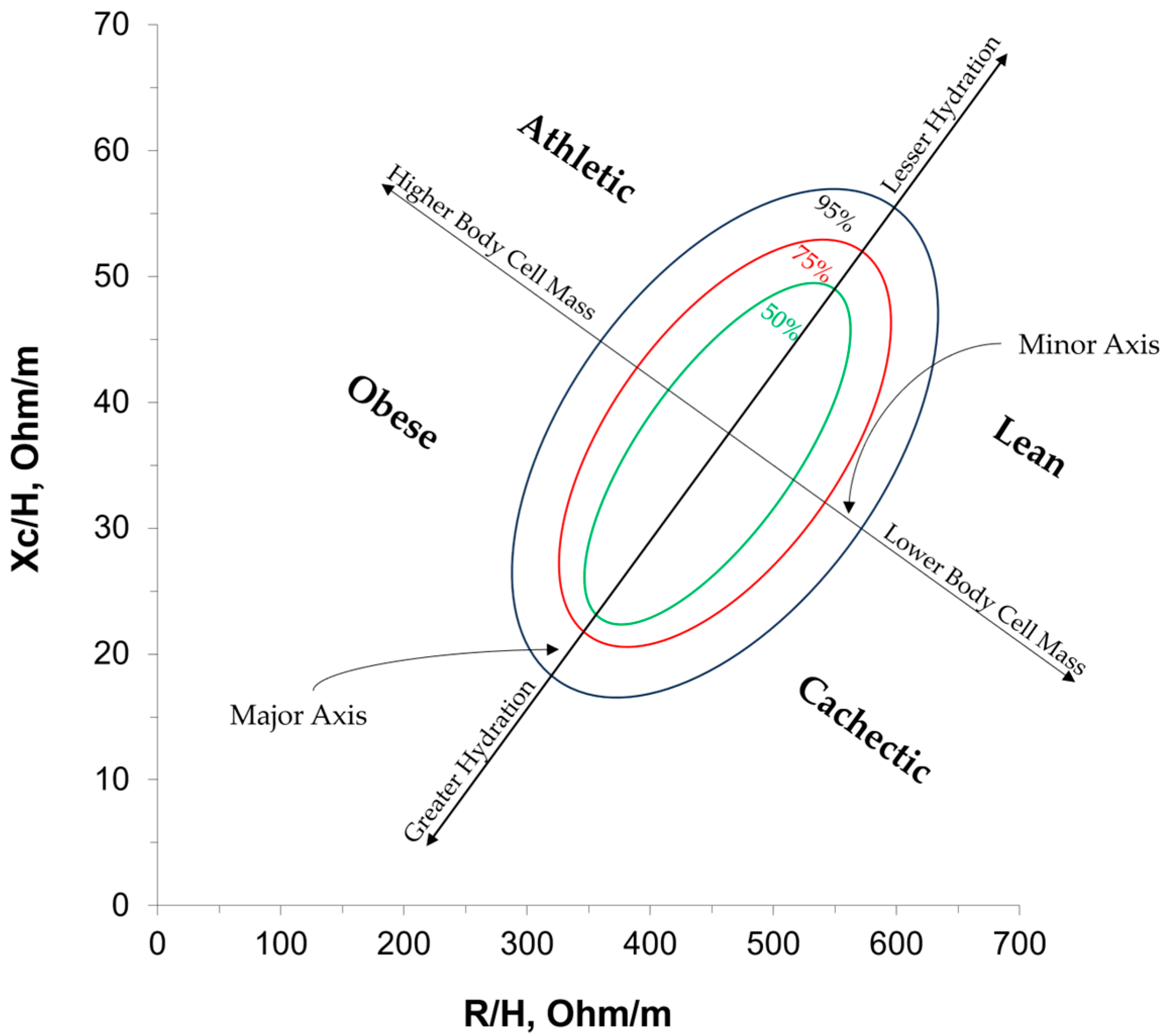
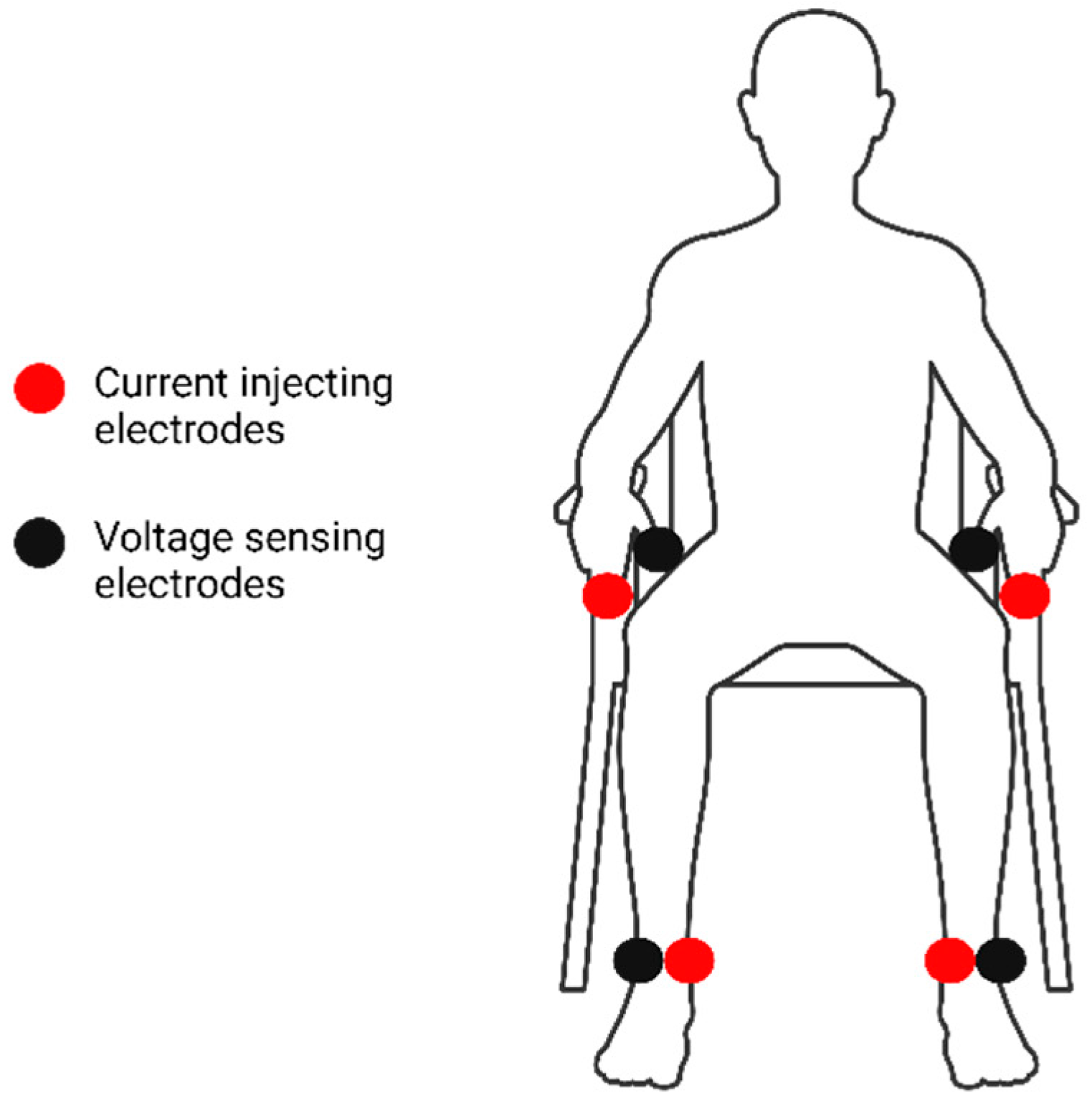
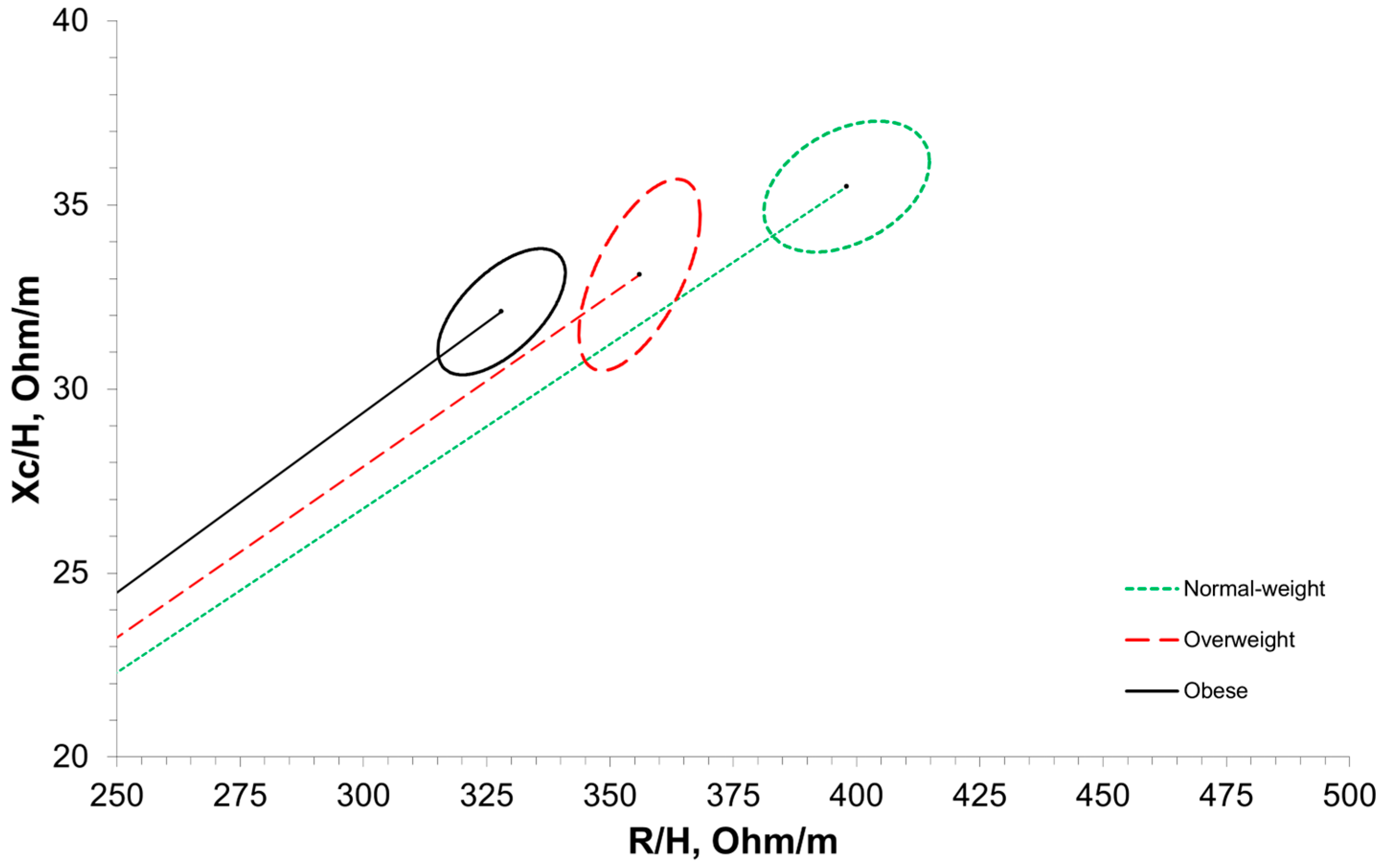
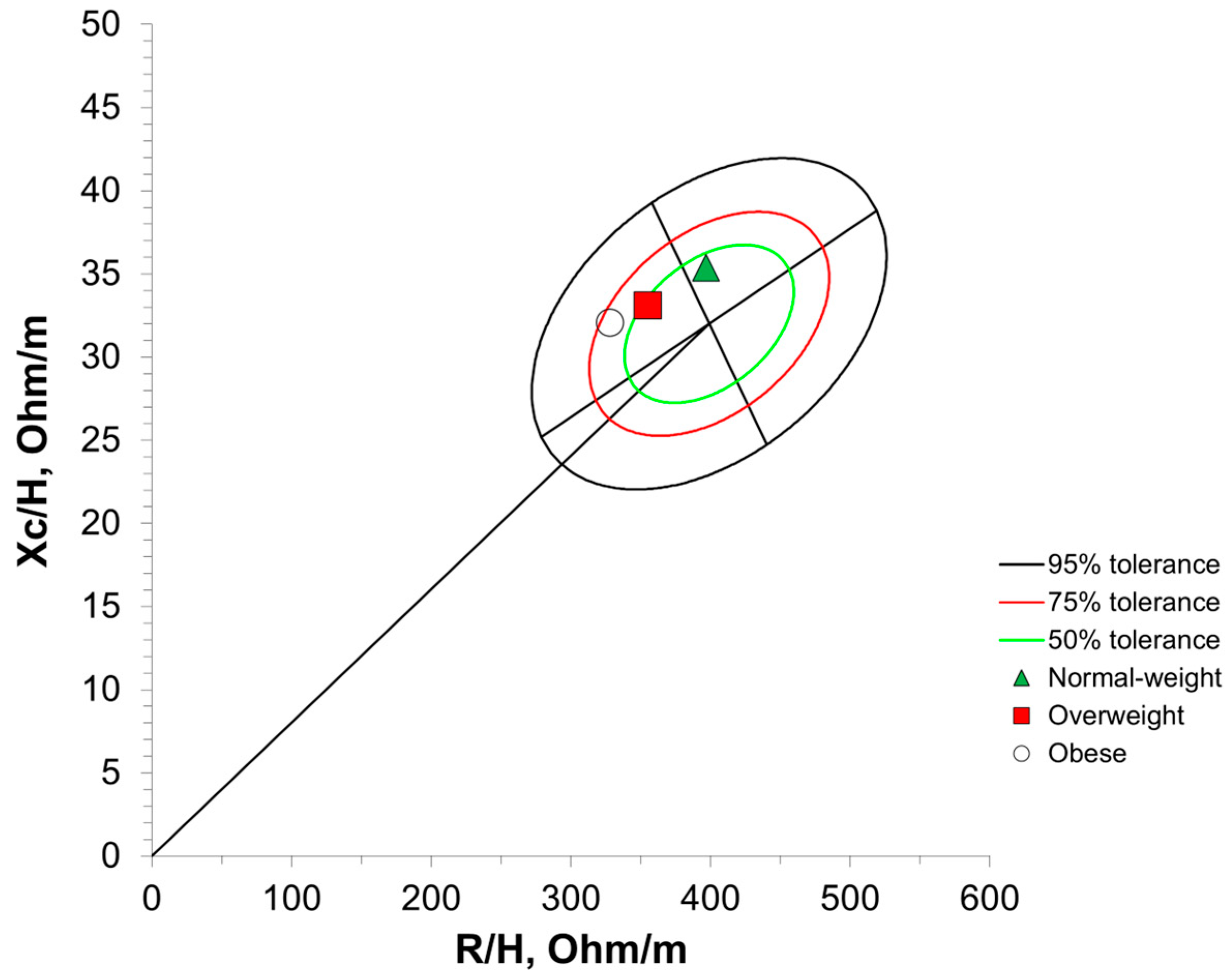

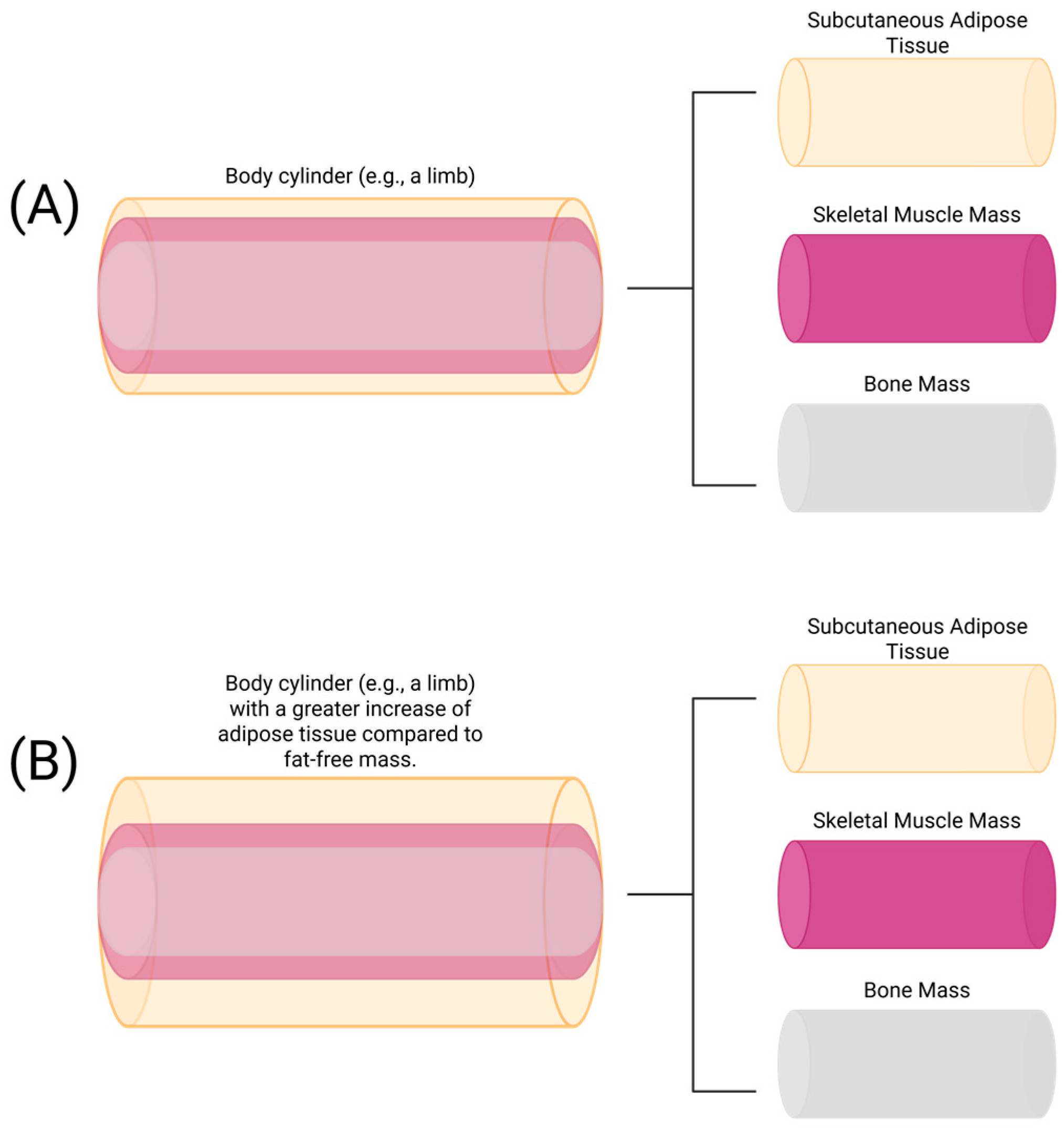
| Variable | All (N = 196) | Normal Weight (n = 45) | Overweight (n = 56) | Obese (n = 95) |
|---|---|---|---|---|
| Mean ± SD or n (%) | Mean ± SD or n (%) | Mean ± SD or n (%) | Mean ± SD or n (%) | |
| Age (years) | 74.5 ± 7.0 | 74.8 ± 7.3 | 76.4 ± 7.2 c | 73.1 ± 6.6 c |
| BMI (kg/m2) | 30.3 ± 6.3 | 23.0 ± 1.3 | 27.3 ± 1.5 | 35.5 ± 4.6 |
| Body Mass (kg) | 75.6 ± 17.7 | 57.2 ± 5.7 a,b | 67.4 ± 7.1 a,c | 89.1 ± 14.7 b,c |
| BF% | 40.2 ± 8.6 | 31.9 ± 7.5 a,b | 37.9 ± 5.8 a,c | 45.5 ± 6.4 b,c |
| SMM (kg) | 24.2 ± 5.0 | 21.2 ± 3.1 b | 22.6 ± 3.9 c | 26.5 ± 5.2 b,c |
| Phase Angle (°) | 5.4 ± 0.9 | 5.1 ± 0.7 b | 5.3 ± 1.0 | 5.6 ± 0.9 b |
| R/height (Ω/m) | 352 ± 52.9 | 398 ± 43.9 a,b | 356 ± 36.2 a,c | 328 ± 50.4 b,c |
| Xc/height (Ω/m) | 33.1 ± 6.7 | 35.5 ± 4.7 b | 33.1 ± 7.7 | 32.1 ± 6.7 b |
| Race/ Ethnicity | AA: 77 (39.4%) | AA: 9 (20.0%) | AA: 14 (25.0%) | AA: 54 (56.8%) |
| A: 13 (6.6%) | A: 5 (11.1%) | A: 7 (12.5%) | A: 1 (1.1%) | |
| H: 72 (36.7%) | H: 20 (44.4%) | H: 26 (46.4%) | H: 26 (27.3%) | |
| W: 31 (15.8%) | W: 9 (20.0%) | W: 9 (16.1%) | W: 13 (13.7%) | |
| O: 3 (1.5%) | O: 2 (4.5%) | O: 0 (0%) | O: 1 (1.1%) |
| Not Controlling for Age | Controlling for Age | |||||
|---|---|---|---|---|---|---|
| Variable | F | p-Value | ηp2 | F | p-Value | ηp2 |
| Body Mass | 143.0 | <0.001 | 0.60 | 139.1 | <0.001 | 0.59 |
| BF% | 70.6 | <0.001 | 0.42 | 69.6 | <0.001 | 0.42 |
| SMM | 27.3 | <0.001 | 0.22 | 24.2 | <0.001 | 0.20 |
| Phase Angle | 4.77 | 0.01 | 0.05 | 3.34 | 0.04 | 0.03 |
| R/height | 36.4 | <0.001 | 0.27 | 35.8 | <0.001 | 0.27 |
| Xc/height | 4.07 | 0.02 | 0.04 | 7.56 | <0.001 | 0.07 |
Disclaimer/Publisher’s Note: The statements, opinions and data contained in all publications are solely those of the individual author(s) and contributor(s) and not of MDPI and/or the editor(s). MDPI and/or the editor(s) disclaim responsibility for any injury to people or property resulting from any ideas, methods, instructions or products referred to in the content. |
© 2025 by the authors. Licensee MDPI, Basel, Switzerland. This article is an open access article distributed under the terms and conditions of the Creative Commons Attribution (CC BY) license (https://creativecommons.org/licenses/by/4.0/).
Share and Cite
Lafontant, K.; Fukuda, D.H.; Chovatia, D.; Latta, C.; Banarjee, C.; Stout, J.R.; Xie, R.; Lopez, J.; Thiamwong, L. Examining Classic Bioimpedance Vector Patterns Between BMI Classifications Among Community-Dwelling Older Women. Sensors 2025, 25, 4181. https://doi.org/10.3390/s25134181
Lafontant K, Fukuda DH, Chovatia D, Latta C, Banarjee C, Stout JR, Xie R, Lopez J, Thiamwong L. Examining Classic Bioimpedance Vector Patterns Between BMI Classifications Among Community-Dwelling Older Women. Sensors. 2025; 25(13):4181. https://doi.org/10.3390/s25134181
Chicago/Turabian StyleLafontant, Kworweinski, David H. Fukuda, Dea Chovatia, Cecil Latta, Chitra Banarjee, Jeffrey R. Stout, Rui Xie, Janet Lopez, and Ladda Thiamwong. 2025. "Examining Classic Bioimpedance Vector Patterns Between BMI Classifications Among Community-Dwelling Older Women" Sensors 25, no. 13: 4181. https://doi.org/10.3390/s25134181
APA StyleLafontant, K., Fukuda, D. H., Chovatia, D., Latta, C., Banarjee, C., Stout, J. R., Xie, R., Lopez, J., & Thiamwong, L. (2025). Examining Classic Bioimpedance Vector Patterns Between BMI Classifications Among Community-Dwelling Older Women. Sensors, 25(13), 4181. https://doi.org/10.3390/s25134181









